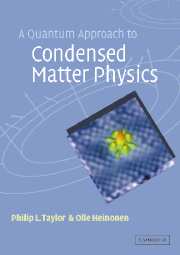Book contents
- Frontmatter
- Contents
- Preface
- Chapter 1 Semiclassical introduction
- Chapter 2 Second quantization and the electron gas
- Chapter 3 Boson systems
- Chapter 4 One-electron theory
- Chapter 5 Density functional theory
- Chapter 6 Electron–phonon interactions
- Chapter 7 Superconductivity
- Chapter 8 Semiclassical theory of conductivity in metals
- Chapter 9 Mesoscopic physics
- Chapter 10 The quantum Hall effect
- Chapter 11 The Kondo effect and heavy fermions
- Bibliography
- Index
Chapter 5 - Density functional theory
Published online by Cambridge University Press: 05 June 2012
- Frontmatter
- Contents
- Preface
- Chapter 1 Semiclassical introduction
- Chapter 2 Second quantization and the electron gas
- Chapter 3 Boson systems
- Chapter 4 One-electron theory
- Chapter 5 Density functional theory
- Chapter 6 Electron–phonon interactions
- Chapter 7 Superconductivity
- Chapter 8 Semiclassical theory of conductivity in metals
- Chapter 9 Mesoscopic physics
- Chapter 10 The quantum Hall effect
- Chapter 11 The Kondo effect and heavy fermions
- Bibliography
- Index
Summary
The Hohenberg–Kohn theorem
In Chapter 2 we explored some of the consequences of electron–electron interactions, albeit in some simple perturbative approaches and within the random phase approximation. There we found that the problem of treating these interactions is exceedingly difficult, even in the case where there is no external one–particle potential applied to the system. We have also explored some of the properties of noninteracting electrons in an external potential, in this case the periodic lattice potential. This led to the concepts of electron bands and band structure, subjects of fundamental importance in understanding the physics of metals, insulators, and semiconductors. Of course, in the real world, electrons in matter are subjected both to electron–electron interactions and to external potentials. How to include systematically and correctly the electron–electron interactions in calculations of real systems is truly a formidable problem.
Why that is so is easily demonstrated. Suppose that we want to solve the problem of N electrons interacting in some external potential. The N-electron wavefunction can be expanded in Slater determinants of some suitable single-particle basis such as plane waves. We can describe the Slater determinants by occupation numbers in our second–quantized notation. Suppose furthermore that we have a basis of a total of Nk plane wave states at our disposal. Here Nk must be large enough that all reasonable “wiggles” of the many-body wavefunction can be included.
- Type
- Chapter
- Information
- A Quantum Approach to Condensed Matter Physics , pp. 182 - 209Publisher: Cambridge University PressPrint publication year: 2002



